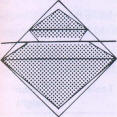The steeply rising prices for rough goods on the diamond market has undoubtedly led to the tendency, clearly observable over the last few years, to cut more and more brilliants with a very shallow crown and its resultant larger table, because of the smaller loss in weight, but, in doing this, the dispersion based on the color separation is ignored because of. the much too small crown facets (Fig 220).
 |
 |
 |
| Fig 220 Various cutting methods of an octahedron | ||
 The
cutter, in proportioning the cut form, generally maintains the correct
angles for the crown and pavilion and only alters the crown height (Fig
221). From this a certain ratio between crown height and table size
results. The shallower the crown, the larger is the table if the crown
angle is constant. If the angle is based on 34.5°, then for example, a
table size of 60 % corresponds to a crown height of 14 %.
The
cutter, in proportioning the cut form, generally maintains the correct
angles for the crown and pavilion and only alters the crown height (Fig
221). From this a certain ratio between crown height and table size
results. The shallower the crown, the larger is the table if the crown
angle is constant. If the angle is based on 34.5°, then for example, a
table size of 60 % corresponds to a crown height of 14 %.
Summary of Ratios
| Table size in %age of the girdle diameter | Crown height in %age of the girdle diameter |
| 52 - 54% | 16% |
| 55 - 57% | 15% |
| 58 - 60% | 14% |
| 61 - 63% | 13% |
| 64 - 66% | 12% |
| 67 - 69% | 11% |
| 70 - 72% | 10% |
If the crown angle is altered these ratios shift. If the crown angle is visibly less than 34.5° then the table is about 2-4 % smaller than the sizes given above. With an obviously larger crown angle, 2-4 % must be added to the table sizes given above.
| Total height | Estimation of crown height |